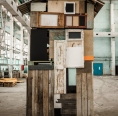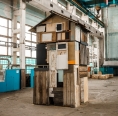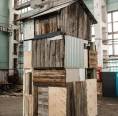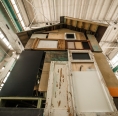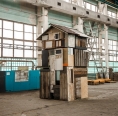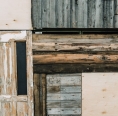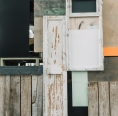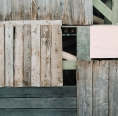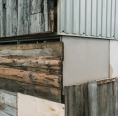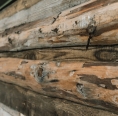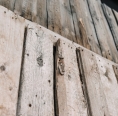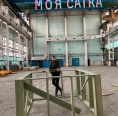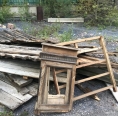-
Cattle-sheds as a new turn in the history of small property
-
Address:
-
Partners:
Aleksey Luchko (Luka), the participant of "My Satka" 3rd international urban development festival, has finalized his new art object. It is a volumetric, three-level structure made from the elements of broken and abandoned cattle-sheds.
How cattle-sheds became art objects
This year Aleksey has implemented several projects in Satka. In June he took part in "Satka Street Art Fest" as part of "Art-Satka" activities, and in autumn he was actively involved in "Arch-Satka" that brought together volunteers, architects and designers to create hardscape elements and improve urban environment.
Why did cattle-sheds come to the center of the artist’s and Sobranie Fund's attention? The reason is that this architectural object tends to become a thing of the past, disappearing from the city map and giving place to new structures and facilities. Some time ago these unsophisticated buildings from waste wood occupied whole districts in such towns as Satka.
They looked like small cartoon houses positioned in rows or clusters, reminding of bird flocks. Each shed was not simply a small property, but a fully functional economic unit that sometimes was part of a horticultural or garage cooperative.
It was the place for people to keep cattle and livestock, sometimes with a cellar to store home cooking or even “second floor” mainly as a dove-house...
According to Valeriya Tsoi, coordinator of cultural projects implemented by Sobranie Fund, a cattle-shed is not just a disappearing architectural object, it is also part of social and cultural heritage that may and should be preserved. How can this be done? By using the new approach offered by Moscow-based artist Aleksey Luchko.
Place specifics
- Aleksey, why did you become interested in cattle-sheds? How did you get the idea to transform them in art objects?
- This idea came to my mind immediately after my first visit to Satka. As a rule, there are always local architectural and cultural objects in small towns. They are characteristic only for a certain region and place. The same happened in Satka: the first thing that grabbed my attention was that Satka citizens have long used and are still using small garages and sheds as the auxiliary space to keep cattle, as workshops or for other purposes. When you are in the town, it is the cattle-shed that becomes the focus of attention. The strange thing is that you may live in an apartment with modern conveniences, but you still have a garage or cattle-shed nearby. It used to be quite all right in the past, but now, in 2018, it looks strange.
People today have summerhouses to keep everything they need without bringing it to the town. But Satka is the place where you still can see cows and dogs in garages and cattle-sheds… Сattle-sheds become less and less common now. It is important to preserve these objects and show their cultural and social meaning which is critical not only for people living in the town (it is part of their life), but for its history as well.
Some cattle-sheds are now demolished to clear the space for new construction, the others are dismantled or get burned… It would be a pity if they disappear as a local phenomenon and no one remembers them. They are very interesting, to my mind.
- How was the image of the new object formed and how did you find the materials?
- It happened organically, in fact. It was easy to find the materials, since cattle-sheds are often dismantled and nobody needs their parts and elements. We just came to sites and took everything we wanted to combine new and old materials in the same object. For example, we took the roof from the old cattle-shed and I repaired and reinforced it. Part of it was left in the original state, with the decayed wood replaced. In addition to that, we used old panels, windows, doors – all architectural elements that were earlier used to build cattle-sheds. I spend a lot of time working with wood, so there were no problems for me to do that.
Link of times
- You’ve mentioned the new materials that you use together with old ones. What is the purpose of that?
The idea was to think and imagine how cattle-sheds would look like if they were still in use now. That’s why we used cheap construction materials that can be easily bought at any building market – profiled sheeting, plywood, any other things of this kind.
In the past cattle-sheds were in most cases made from wood boards that were cheap and affordable. Today it is much easier to find old wooden pallets and plywood. Our cattle-shed is partly made from old materials that remind of the past, but at the same time it boasts clear, geometric, glossy forms that are used nowadays.
- Why is it tall?
- First of all, we have chosen an interesting location for our art object. It is a small hill which makes it easier to see the cattle-shed. That’s why it is tall. It is an architectural object and it should dominate the local environment. Secondly, all cattle-sheds used to be different, with one or two floors. In addition to that, the place for the art object was chosen with account for the fact that there are still some other cattle-sheds in the nearby that go to ruin gradually.
I’m fond of that, because there is an immediate association with old cattle-sheds, and how they looked in the past and now… It’s a great opportunity to see the similarities and differences between the reality and art object.
- Is it only to be looked at or can one get inside?
- No. It’s for visual perception only. The most important idea is to feel the link with somebody who used to live here, close to these cattle-sheds, or even used them. We did not create the interior due to many reasons. First of all, cattle-sheds were used for different purposes and we didn’t want to do anything particular, for instance, an imitation of somebody keeping cattle or using the space as a workshop. There are numerous alternatives and it was very difficult to choose. Secondly, our object is not guarded and it’s hard to predict how people would use it in this case. It is highly likely that somebody would take possession over it. Maybe, it’s not that bad, after all. Time will show.
- The site where we are planning to install our art object (on the way to the old plant) has no name now, but it is possible that someday people will say: “It is the road turn where the cattle-shed is located”. Eventually it may get the status of the main or the only cattle-shed in Satka, adds Valeriya Tsoi.
- What about the color palette? Was there the need to use any accents in terms of colors or anything else?
- There’s no special color palette, just some reference to modern materials of burgundy, pale brown, blue and green colors. On the whole, we used natural colors that are typical for old materials. I did not treat them in any special way, because they create the association with old buildings. We might add certain accents to the window opening, but I would like the cattle-shed to look natural and organic. That’s why I avoid using any bright or garish colors.
Associations, city colors and the most important things
- You’ve mentioned associations several times. And what do you associate Satka with?
- With nature, because this place is surrounded by mountains. In addition to that, I associate it with nice people, magnesite, pelmeni, orange color and cattle-sheds. There’s also an association with red color (Proletarskaya street), but I’m not completely sure about that.
- Are there any colors that our town lacks?
- It seems that all colors are present. There are a lot of bright and unusual things in the town. I came here for the first time in summer, and my second visit was scheduled for autumn. During this period there were many changes, some of them for the better, but sometimes for the worse. The most important issue is that changes do take place and the urban environment transforms very quickly.
- The street art festival, that you took part in, was one of the big events that influenced the town transformation process. To what extent was it significant for a small town, its residents, urban environment and architecture, and what was of particular interest for you personally?
- Any initiatives and festivals are important and necessary. We should understand clearly what we are doing and what we are aiming at. Satka is a small town, which means that when creating something, we should be careful not to overdo it, like in the situation with red color in Proletarskaya street, and keep in mind the characteristics of architectural and urban environment together with visual perception. When you are walking along the street with red lights, red pavements, red benches, red fence, red bins and red houses, you get some kind of discomfort feeling. This is the example of having overdone it, and in the course of time the visual perception of such unnatural environment will be more and more difficult.
- When vising a new place, do you pay attention to objects that you could use for your artistic projects or future art festivals?
- As what?
- As a canvas, for instance.
- Satka has some objects of this type, but I would prefer to use hardscape elements.
- This was exactly the focus of attention of the young people who took part in the "Bright Satka" project and started to create paintings on stairs, swings and kiosks… Is there anything else that you can recommend?
- The most important thing is to do something. When you create new things with your own hands, it is always followed by the development of the surroundings.
Street art festivals are very useful in this sense, because they give people a different view on usual things and open new possibilities. Many people start to improve their residential area or try to change something in the city. There’s a plenty of objects for creativity and changes. I would pay more attention to hardscape elements, such as bus stops, playgrounds, public space that can be used for recreation and other purposes.
Special energy
- Why do you mainly use wood in your works? Even in case with waste materials, such as plywood, chipboard or something else, there’s always wood being a part of it.
- I like wood, it radiates the unique type of energy. In addition to that, I do everything myself, with my own hands. It is a noble material, and it looks beautiful. Russian wooden architecture started with wood as the main material with rich history. Different materials have their own history, you know. On top of that, the affordability of wood plays an important role, and it is easy to work with – you know what to do and how…
CATTLE-SHED means premises for cattle and livestock.
According to people who have lived here for long, first cattle-sheds were constructed in Satka in 1960’s. The construction started in the central part of the town, between sickle and hammer on the one side and Proletarskaya street on the other side.
“Many Satka citizens had cattle at that time. The herd was very big, more than 100 animal units”, says Viktor Aleksandrovich Nemchinov, Magnesite veteran and former curator of the plant museum. “Some cattle-sheds were demolished late in 1960’s, when construction of school №4 started, the others ceased to exist in the beginning of 2000’s, when they were replaced with high-rise houses in Metallurgov street”.
In summer 2014 Satka’s cattle-sheds were studied by students of IV Summer School of NRU HSE Culturology Department: “The second stage of the project known as “Distributed Way of Living in a Russian Single-Industry Town” completed. Within its scope, field work research was carried out in Satka district of Chelyabinsk Region in July 2014… Following the field works with garage infrastructure, we have developed the guidance that takes notice of the specific features of this provincial town. The research team conducted a set of in-depth interviews on the territory of several garage cooperatives where the garages, cattle-sheds, dove-houses and workshops are located.
In the process of work the relevant forms of distributed ways of living were identified. They related both to garages (or sheds) and the specific economic set-up, with a garage being the connecting link between one’s apartment and summerhouse, the “second home”, a workshop, “memory space”, locus of “men’s culture” or a rudimentary element. Apart from interviews, the research team worked with the archive in order to study the garage infrastructure in the context of Soviet history, food procurement system in urban settlements and further transformation that took place late in 1980’s-1990’s. In addition to that, statistics on the existing garage cooperatives was collected. The interviews also touched upon garage infrastructure problems in the context of public space and urban culture development, neighborhood and informal relations”.
A cattle-shed is both a summerhouse and celebration place: «On Sunday our group goes to a huge site built up with garages and cattle-sheds, in the search of partners to speak with. I turn round the corner and see the unusual excitement. It is Rosa’s birthday today. The table is ready, there are six people in the cattle-shed. Marat is cooking the meat and telling me about local sights at the same time. Eduard, who took on holiday look (jogging pants and glasses), hunkers down. The interview could hardly be called successful, I refused the eats and drinks, but the experience resulting from the use of distributed living elements turned out to be unexpected”, reads one of the posts by Vitaly Kurennoy, head of IV Summer School of NRU HSE Culturology Department in the group «Social & Cultural Development of Satka Municipal District” in Facebook.
In September 2014 cattle-sheds were a matter in dispute. The website of Satka District Administration informed: “Temporary structures were erected in Soviet era due to food shortage, in order to compensate for the lack of food products in shops and as a tribute to local residents’ rural origins. That was the time when livestock-breeding cooperative Zarya was established. The process did not envisage the construction of capital structures. Early in 2000’s the partnership was liquidated based on the order of city executive, and it has been for more than 10 years already that cattle-shed owners are asked to demolish the illegal buildings, all the more so as there are no entitlement documents that would comply with the applicable legislation… The unrest started in July, when the students of NRU HSE Summer School were studying cattle-sheds as a cultural phenomenon of our city. “In fact, it is the psychological therapy for people. They stick to them not as some kind of economic benefit, but the way of life and a method to escape depression”, said Vitaly Kurennoy, professor of NRU HSE… In the former Zarya Cooperative there are a bit more than ten cattle-sheds are left and they are used to keep 11 cows. District and city executives are ready to meet personally with each owner and settle the issue using the case-by-case approach…”
Anna Filippova. Photo by Denis Shakirov, organizers.
-
26.08 - 26.08
DIARY OF THE THIRD INDUSTRIAL BIENNALE
-
28.11 - 28.11
MY SATKA FESTIVAL WINS THE CONTEST OF CORPORATE VOLUNTEER PROJECTS
-
13.10 - 15.10
COOPERATION WITH VGIBL NAMED AFTER M.I. RUDOMINO


